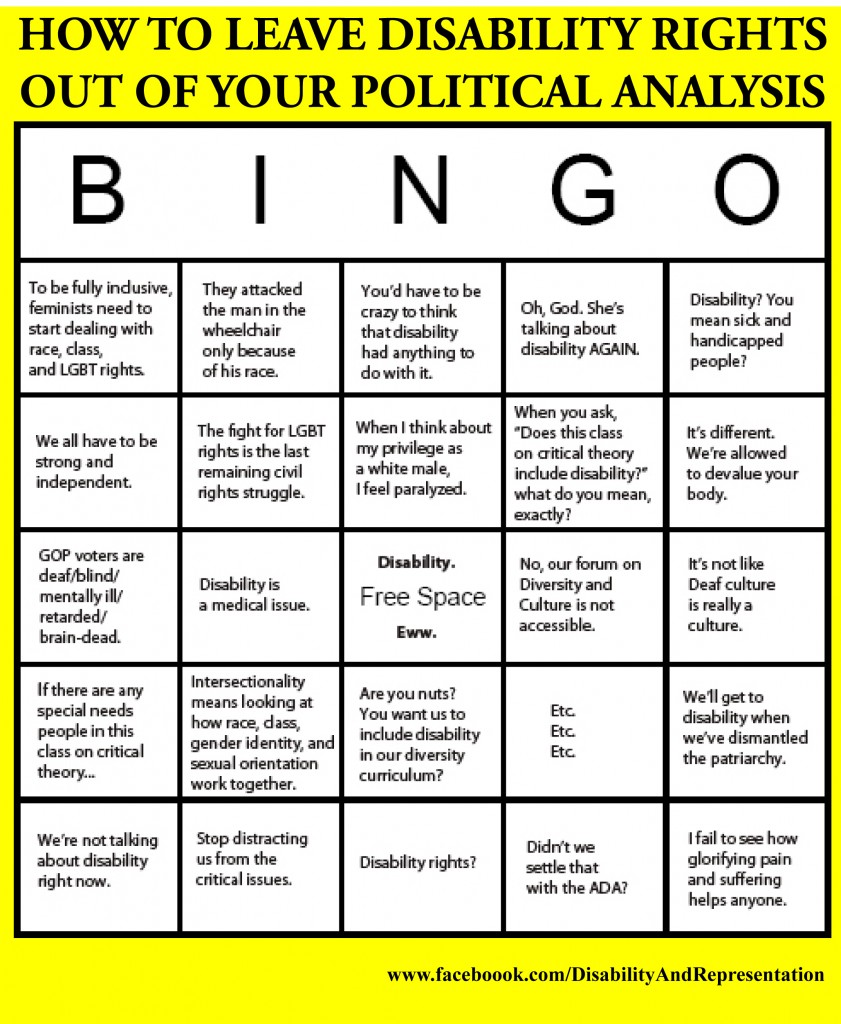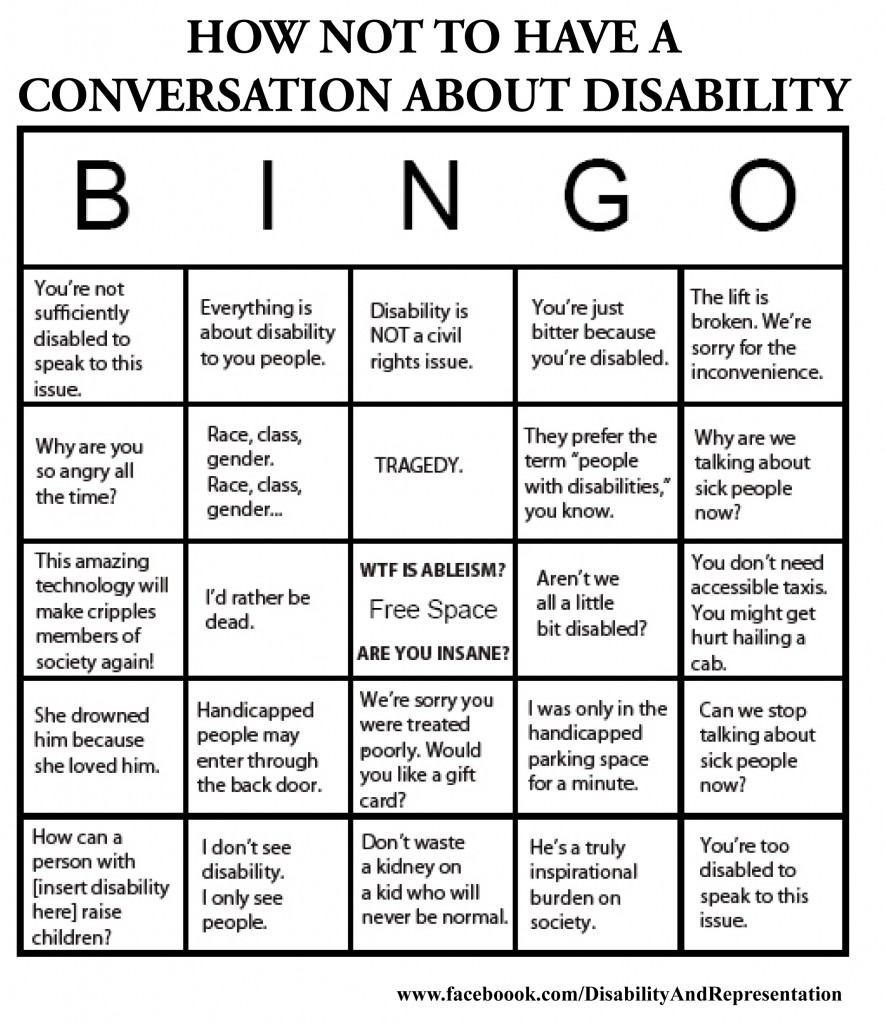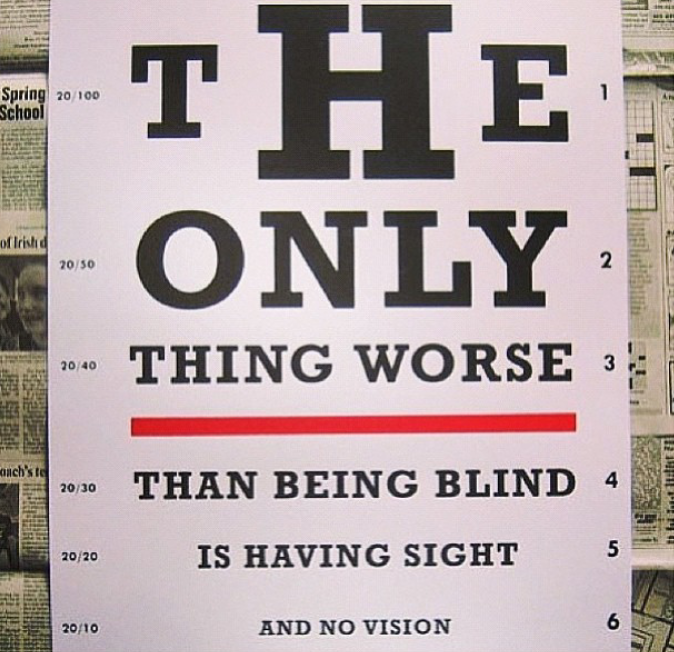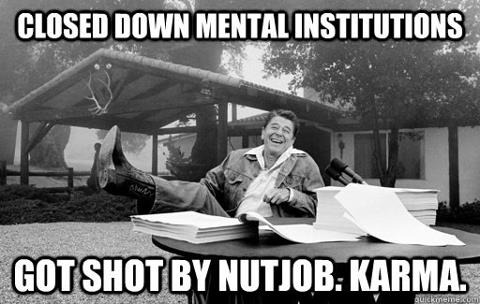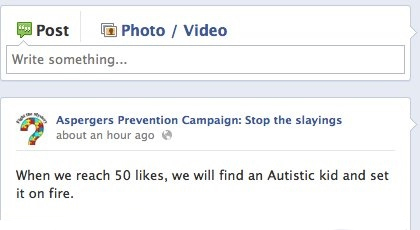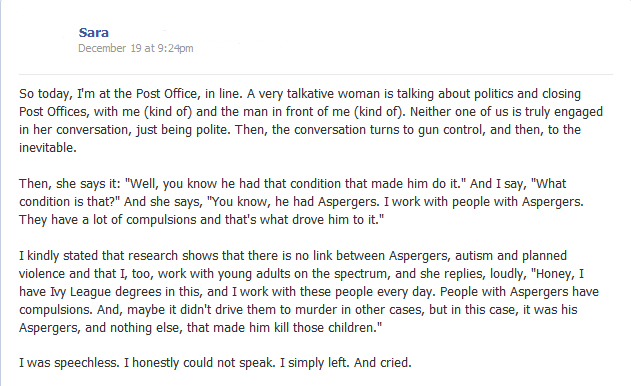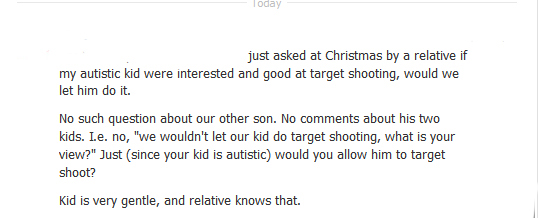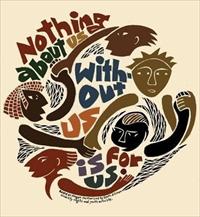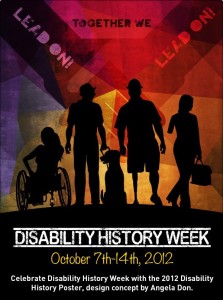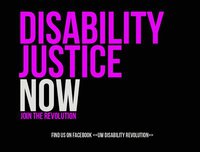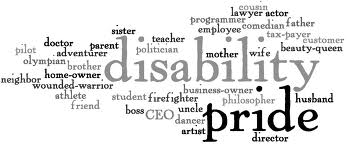How to Leave Disability Rights Out of Your Political Analysis
[The graphic is a Bingo card with 25 squares.
Title: How to Leave Disability Rights Out of Your Political Analysis
Top row:To be fully inclusive, feminists need to start dealing with race, class, and LGBT rights.
They attacked the man in the wheelchair only because of his race.
You'd have to be crazy to think that disability had anything to do with it.
Oh, God. She's talking about disability AGAIN.
Disability? You mean sick and handicapped people?
Second row: We all have to be strong and independent.
The fight for LGBT rights is the last remaining civil rights struggle.
When I think about my privilege as a white male, I feel paralyzed.
When you ask, “Does this class on critical theory include disability?” what do you mean, exactly?
It's different. We're allowed to devalue your body.
Third row: GOP voters are blind/deaf/mentally ill/retarded/brain-dead.
Disability is a medical issue.
Free Space: Disability. Eww.
No, our forum on Diversity and Culture is not accessible.
It's not like Deaf culture is really a culture.
Fourth row: If there are any special needs people in this class on critical theory...
Intersectionality means looking at how race, class, gender identity, and sexual orientation work together.
Are you nuts? You want us to include disability in our diversity curriculum?
Etc. Etc. Etc.
We'll get to disability when we've dismantled the patriarchy.
Last row: We're not talking about disability right now.
Stop distracting us from the critical issues.
Disability rights?
Didn't we settle that with the ADA?
I fail to see how glorifying pain and suffering helps anyone.
The text below the graphic reads www.facebook.com/DisabilityAndRepresentation.]
© 2013 by Rachel Cohen-Rottenberg
How Not to Have a Conversation about Disability
[The graphic is a Bingo card with 25 squares.
Title: How Not to Have a Conversation about Disability
Top row: You're not sufficiently disabled to speak to this issue.
Everything is about disability to you people.
Disability is NOT a civil rights issue.
You're just bitter because you're disabled.
The lift is broken. We're sorry for the inconvenience.
Second row: Why are you so angry all the time?
Race, class, gender. Race, class, gender...
TRAGEDY.
They prefer the term "people with disabilities," you know.
Why are we talking about sick people now?
Third row: This amazing technology will make cripples members of society again!
I'd rather be dead.
Free space: WTF is ableism? Are you insane?
Aren't we all a little bit disabled?
You don't need accessible taxis. You might get hurt hailing a cab.
Fourth row: She drowned him because she loved him.
Handicapped people may enter through the back door.
We're sorry we treated you so poorly. Would you like a gift card?
I was only in the handicapped parking space for a minute.
Can we stop talking about sick people now?
Last row: How can a person with [insert disability here] raise children?
I don’t see disability. I only see people.
Don’t waste a kidney on a kid who will never be normal.
He’s a truly inspirational burden on society.
You’re too disabled to speak to this issue.
The text below the graphic reads www.facebook.com/DisabilityAndRepresentation.]
© 2013 by Rachel Cohen-Rottenberg
To My White Brothers and Sisters: Fess Up. You Know What Zimmerman Was Thinking. Of Course You Do.
This piece is not explicitly disability related, but because all oppressions work along similar lines, many of the issues raised by the death of Trayvon Martin resonate in my experience as a disabled woman — particularly the whole question of who gets to occupy space and who gets treated with hostility for trying to do so. More and more, as I watch how people occupy space together, I see the outlines of how our society and its hierarchies are constructed. Racism is part of that. Ableism is part of that. All forms of bigotry are part of that. They intersect and they support one another, and they all rely on nearly full-scale denial that any of it is happening at all. This post is my attempt to break through one part of that denial.
The Department of Justice is opening an investigation into whether to indict George Zimmerman on civil rights charges in the death of Trayvon Martin. The bar for such prosecutions is high; the government must prove Zimmerman’s state of mind on the night that Trayvon was killed. In other words, they must prove that he followed and killed Trayvon because he was black.
This standard has been echoed on Internet comment forums in the words of people who keep repeating the same questions over, and over, and over: How do you know what was in George Zimmerman’s mind? How do you know that he was acting out of racist motives? Over and over, I hear people say that we shouldn’t judge the man, that we don’t know what was in his mind and heart, that we should be charitable and exercise caution in jumping to conclusions.
I have just one thing to say to that:
Bullshit.
Listen up, my white brothers and sisters. I’m white. You’re white. We can talk freely here, yes?
We all know very well what was in George Zimmerman’s mind, because the same thing is in our minds when we see a young black man in a hoodie walking down the street at night. Our shoulders tense up. We feel suspicion. We start thinking “danger.”
Most of us have the good sense to be ashamed that we feel that way. Most of us have the good sense not to follow the man.
But maybe we walk a little faster. Maybe we lock our car doors. Maybe we cross the street. Or maybe we take a deep breath, suck up the fear, and walk by that young black man in a hoodie hoping against hope that nothing bad happens.
You know it’s true.
I feel all of these fears. All of them. They go through my mind and body before I’m even aware of it happening. I keep myself from crossing the street and locking my car doors because I ‘ll be damned if I’m going to disrespect a man for using a public road.
But it’s horrifying to me that after several decades of knowing full well how racism works and how it demeans and how it kills that all of these suspicions course through me in a millisecond, before my head even has a chance to catch up. It’s as though something from the outside has come in without my consent — something that doesn’t originate in me but lives in me nonetheless.
I used to wonder how this could be. I was raised in an anti-racist household. My parents would never have forgiven me if a racial slur had ever come out of my mouth. They made me understand that my cozy little white corner of the world was an accident of fate, and that it was my responsibility to take my privilege and be the ally of people without that privilege. I’ve been working for peace and justice my whole life.
I was raised to know better. That’s the constant refrain I hear from my white brothers and sisters: How could I be racist? My parents raised me to treat everyone equally.
I’m here to tell you what you don’t want to hear: It doesn’t matter. When it comes to the impact of full-scale systemic racism, being well-raised doesn’t provide a force-field that protects anyone. At best, being well-raised provides a set of values and a mode of critique for the racism we carry and its dire consequences. But when it comes to protecting us from the indoctrination of an entire culture, the teachings of our individual upbringings cannot possibly compete with the constant, unrelenting, and merciless messages we’ve heard from the day we were born.
We were born into a cultural narrative that says that black men are aggressive, dangerous, and not to be trusted.
We were born into a cultural narrative in which the black man is always the aggressor, always at fault, always suspect.
We were born into a culture that speaks this narrative so often and with such force that there is nowhere to go to get away from it.
We were born into a culture in which fear and loathing and indoctrination into racism have been going on for centuries and will continue to go on after we’re gone. All we can do is fight them in the here and now so that maybe someday, they’ll be gone forever.
Now, if it makes your well-intentioned soul feel any better, I can tell you that the world you inherited is not your fault. It’s not your fault we’re all neck deep in this shit.
It’s not your fault that you were born into this world, but it’s your responsibility to admit to its hold on you and to stop pretending that oppressed people are over-reacting to the bigotry that swirls around them every damned day. It’s not your fault that all of this crap is in your head, but it’s your responsibility to acknowledge it and to root out as much of it as you can. It’s not your fault that you’ve been conditioned to feel fear, but it’s your responsibility to admit to the feeling in your gut when you see young black men walking down the street at night.
It’s not your fault that you feel all of these things, but it’s your responsibility to not let your shame keep you from being an ally of the people fighting them.
Yeah, it’s hard work. Yeah, no one wants to admit that they carry racism or ableism or homophobia or any other kind of bigotry. But guess what? We all do. Who can possibly escape these things when our entire culture is saturated with them?
I know it’s hard to hear someone suggest that maybe you’re not as neutral and as color-blind as you think you are. It’s painful. But while you’re feeling how hard it all is, please remember this: In the country in which you live, black men are taking their lives in their hands just to go out to get their groceries. Black men have to live with suspicion every time they try to occupy space. Black men have to live with white people pretending that none of this is happening.
Admitting to what’s in your mind and heart cannot possibly be as difficult as that. So go ahead and do it. Because it’s the secret that everyone already knows.
© 2013 by Rachel Cohen-Rottenberg
More Ableism from Our Friends on the Left
I just found this graphic on a Facebook page called Moving The Sun To Shine in Dark Places:
[The graphic shows an eye chart with the text "The only thing worse than being blind is having sight and no vision."]
It’s appropriate in this context to note that I spell out the text on the graphic in order to make the blog accessible to my blind readers. Because yes, indeed, my abundantly well-intentioned friends on the left: Blind people read. They even read blogs. On the Internet!
But I digress.
About your graphic… How can I put this? I’ll try to be as direct as possible: Using the word “blind” as a pejorative is not the way to go when you’re fighting for social justice.
Why? Okay, let me spell it out.
In this context, “blind” is entirely negative — nearly the worst thing that could happen to a person. And the people worse off? The ones who can literally see, but who have no vision for making the world a better place. Thus, blind people are just one tragic step above people who are too cowardly, or too selfish, or too morally bankrupt to care whether the world goes to hell in a handbasket.
You see, you lost me when you attempted to inspire people to moral action by appropriating the experiences of disabled people and attempting to speak in their voices. You looked at blind people and assumed that blindness is a tragic condition, roughly synonymous with an absence of moral and philosophical vision. And then you used your outsider’s judgment of a situation about which you know nothing to bolster your cause. You fell into one of the worst tropes our society has to offer about disabled people: that disability is a physical and moral tragedy.
May I make a suggestion? When you’re fighting for social justice and general kumbaya, avoid the ableist language. Is that so hard?
© 2013 by Rachel Cohen-Rottenberg
Neurotypical Awareness: Some Clarifications of Intent
I’m really gratified by how many people have shared my Neurotypical Awareness memes and all the great comments that these memes — you should pardon the expression — have inspired. Based on some of the comments I’ve seen over the past week, though, I feel it necessary to clarify a few things for people who are unfamiliar with my work and approach.
The intent of the Neurotypical Awareness memes is not to parody individuals or their concerns. For instance, I’m not saying that raising an autistic kid is easy, and I’m not saying that being autistic is easy, and I’m not saying that people should be quiet about it. Physically, socially, economically, emotionally, and in many other ways, it can be very difficult — because of the nature of the condition and because of the obstacles that the world puts up. What I’m doing is parodying representations of autism — by professionals and organizations and media outlets — that constantly beat the drum about how autism is nothing but tragedy and grief and loss and deficit, or conversely, a grand opportunity for Special Inspirational Achievement and Overcoming the Odds.
I don’t think those extremes help us. And those are generally the extremes at which most mainstream autism representation works. The same is true for mainstream representations of most — if not all — disabilities.
It’s clear that a number of people feel uncomfortable about these memes. My feeling is that this discomfort is a good thing. If people are uncomfortable when reading them, then what I’m doing is effective. People should feel uncomfortable when the shoe is on the other foot and pejorative attitudes are directed at them or at those they care about. I want people to have the experience of how it feels for disabled people to deal with these kinds of messages day in and day out.
The problem, from my perspective, isn’t that people get offended. The problem is that people get offended and then don’t question why they’re offended and why I’d want them to feel that.
Several people have said that I’m just being negative. But that’s not me. I don’t do negative for the sake of negative, and I have no interest in paying back the non-disabled world for the way it treats us. I don’t think about life that way. My only interest is to shine a light on our cultural memes about disability and on their impact.
In other words, this isn’t therapy. It’s social commentary. And if it makes you uncomfortable, then I’m doing my job.
© 2013 by Rachel Cohen-Rottenberg
What Autism Awareness Means at Autism Speaks
Autism awareness. Just when you think it couldn’t get any more annoying, it does. And it’s only April 2nd.
Apparently, the folks at Autism Speaks, in their infinite wisdom about all things autism, decided it would be an excellent idea to spend good money (you know, the kind that might actually go for supports and services and other boring and unimportant things) on a useless piece of technology. How useless?
Very useless. This technology allows people to imagine how parents might feel when their autistic kids don’t make eye contact with them.
Yes. It’s a simulation exercise to make people aware of the utter heartbreak of having a child who struggles with eye contact. Except, of course, in this video, the child isn’t struggling. The child simply does not make eye contact at all. Ever.
Take a look:
Source: Autism Speaks, Ad Council
What’s this video about? It’s about how other people feel about autistic people.
It’s not about how autistic people feel when others try to make eye contact. It’s not about why autistic people have difficulty with eye contact. It’s not about why autistic people often avoid eye contact. It’s not about why eye contact can be emotionally and neurologically overwhelming for autistic people.
No. It’s all about what a bummer it is for others that we have this disability at all — if lack of eye contact can even be called a disability. In some cultures, too much eye contact is considered rude. Are people in those cultures crying their eyes out over a lack of sustained eye contact? It’s doubtful.
But of course, Autism Speaks’ message isn’t about understanding. It’s about awareness. Of how other people feel about us.
And it’s utterly shameful.
© 2013 by Rachel Cohen-Rottenberg
Ableism on the Left is Still Ableism
If you consider yourself politically progressive, chances are that you firmly believe that racism, classism, misogyny, homophobia, anti-Semitism, Islamophobia, and all other forms of bigotry have no place in political discourse or civil society. As a fellow progressive, I wholeheartedly agree.
So why, oh why, is ableism perfectly fine with you? Why, oh why, do you find it perfectly all right to engage in bigotry against disabled people for the purpose of your political agenda?
May I share a representative example? Consider the following graphic, which was posted to a Facebook page called The Republican Party- Is Corruption, Greed & Lies and The Real Evil Empire.
Source: Facebook [The graphic consists of a black-and-white photograph of former president Ronald Reagan sitting with one foot resting on a round table. The table has two stacks of paper on it; some of the pages are draped over the stacks. Behind him is the front of a house and two leafy trees. The text reads: "Closed Down Mental Institutions. Got Shot by Nutjob. Karma."]
Now, for what it’s worth, I’m willing to believe that you mean no harm. I’m willing to believe that, despite your progressive credentials, you are blissfully unaware of the bigotry you carry against disabled people. In fact, I am more than willing to believe that, despite your progressive credentials, you have no idea what ableism is.
Allow me enlighten you.
Ableism is the belief that nondisabled people are worthier human beings than disabled people. Ableism is the belief that nondisabled people should have a different set of rights than disabled people. Ableism is the belief that disabled people should be segregated, patronized, sneered at, laughed at, abused, and dismissed.
But it’s more than a belief. It plays itself out in systemic injustices — in high rates of unemployment, in high rates of poverty, and in high rates of abuse. It plays itself out in exclusion — social exclusion, economic exclusion, and architectural exclusion. It plays itself out daily in the ways in which disabled people become metaphors for social ills and our culture’s deepest fears.
In others words, it plays itself out just as any other form of bigotry plays itself out — as a series of assumptions, as a set of structural inequities, and as a barrage of microaggressions that take place every hour of every day. And as is true for any other form of bigotry, engaging in ableism while meaning no harm is not a defense against actually doing it.
The graphic you posted is ableist. Why?
Because calling a mentally ill person a nutjob is ableist.
Because implying that mentally people are all violent offenders is ableist.
Because suggesting that mentally ill people who have committed no crime should be incarcerated is ableist.
Because allowing comments in response to this graphic like “Ooh! Ooh! I’ve got one! What’s Reagan’s favorite vegetable? James Brady!” without calling them out is ableist.
Wake up, my fellow progressives. You can’t root out bigotry in this world while engaging in it. You ought to know that.
© 2013 by Rachel Cohen-Rottenberg
Scapegoating Schizophrenia: Paul Steinberg’s Shameful New York Times Op-Ed Column
The scapegoating continues.
This week’s New York Times Op-Ed page features an utterly irresponsible article in which psychiatrist Paul Steinberg baselessly blames schizophrenia for mass shootings. In a truly chilling fashion, Dr. Steinberg argues that, in order to prevent such tragedies, we need to stop worrying our heads about the civil rights of people with schizophrenia:
[W]e have too much concern about privacy, labeling and stereotyping, about the civil liberties of people who have horrifically distorted thinking. In our concern for the rights of people with mental illness, we have come to neglect the rights of ordinary Americans to be safe from the fear of being shot — at home and at schools, in movie theaters, houses of worship and shopping malls.
Dr. Steinberg makes a pejorative and unsubstantiated association here between schizophrenia and the mass shootings that have taken place in 2012. He refers to shootings “at home and at schools” (a clear reference to the December 14 Newtown, Connecticut massacre), “in movie theaters” (a clear reference to the July 20 Aurora, Colorado theater shooting), “houses of worship” (a clear reference to the August 5 shooting at a Sikh Temple in Oak Creek, Wisconsin), and “shopping malls” (a clear reference to the December 11 shooting at a shopping mall in Portland, Oregon).
Terrifying events, to be sure. But before we start tossing people’s civil liberties out the window, let’s look at whether any of the perpetrators of these violent acts actually had schizophrenia:
As far as we know, Adam Lanza, the Newtown shooter, was not diagnosed with schizophrenia, nor have we heard evidence that he was delusional.
James Holmes, the shooter in Aurora, saw a psychiatrist who specializes in schizophrenia — which means precisely nothing regarding his own diagnosis. Her practice was not limited to people with schizophrenia. He has not been diagnosed with the condition.
Wade Michael Page, who murdered six people at a Sikh Temple, was a racist skinhead who no one has ever remotely hinted showed signs of schizophrenia.
Jacob Tyler Roberts, who was responsible for the shooting at the mall in Portland showed no signs of delusional thinking to anyone around him, including his girlfriend.
But that doesn’t stop Dr. Steinberg from coming up with two new culprits:
At Virginia Tech, where Seung-Hui Cho killed 32 people in a rampage shooting in 2007, professors knew something was terribly wrong, but he was not hospitalized for long enough to get well. The parents and community-college classmates of Jared L. Loughner, who killed 6 people and shot and injured 13 others (including a member of Congress) in 2011, did not know where to turn.
Of course, Seung-Hui Cho was never diagnosed with schizophrenia in his lifetime. Psychiatrists like Dr. Steinberg have only done so post-mortem, and the more responsible ones acknowledge that they cannot make such a diagnosis with any certainty. The only mass murderer to whom Dr. Steinberg makes reference who has actually been diagnosed with schizophrenia is Jared Lee Loughner.
There are very good reasons that psychiatrists have to meet a client in person in order to render a diagnosis: second- and third-hand testimony is notoriously unreliable, and diagnostic assessments can take days to complete. Oddly enough, Dr. Steinberg seems to be aware that he is breaking the ethical standards of his profession by diagnosing people he has neither met nor treated:
I write this despite the so-called Goldwater Rule, an ethical standard the American Psychiatric Association adopted in the 1970s that directs psychiatrists not to comment on someone’s mental state if they have not examined him and gotten permission to discuss his case. It has had a chilling effect. After mass murders, our airwaves are filled with unfounded speculations about video games, our culture of hedonism and our loss of religious faith, while psychiatrists, the ones who know the most about severe mental illness, are largely marginalized.
As far as I can see, the only “unfounded speculations” here are coming from Dr. Steinberg. It is hard to imagine how an affluent psychiatrist in private practice could imagine himself to be “marginalized,” particularly when it comes to armchair diagnoses. Given that his entire piece further marginalizes an entire group of people who already far more likely to be the victims of violent crime than to be the perpetrators, the term rings especially hollow.
To his credit, Dr. Steinberg does acknowledge schizophrenia is not generally associated with violence, though he then turns around and contradicts himself:
The vast majority of people with schizophrenia, treated or untreated, are not violent, though they are more likely than others to commit violent crimes.
Dr. Steinberg rather skews the evidence here. In fact, people with schizophrenia are not more likely to commit violent crime when one factors in the presence of substance abuse. A PLoS study found that, when controlling for the presence of drug and alcohol abuse, people with psychosis are no more likely to commit violent crime that people without psychosis:
Importantly the authors found that risk estimates of violence in people with substance abuse but no psychosis were similar to those in people with substance abuse and psychosis and higher than those in people with psychosis alone. (Gulati et al. 2009)
In other words, people with no psychosis who abuse alcohol and drugs have a higher risk of committing a violent crime than people with psychosis who do not abuse alcohol and drugs, and a similar risk to people with psychosis who do. The factor to be looking at is drug and alcohol abuse, not schizophrenia.
That point seems to have been lost on Dr. Steinberg. He should know better. Shame on him.
References
ABC News. “Clackamas Town Center Shooting: Who Is the Alleged Shooter?” http://abcnews.go.com/GMA/video/clackamas-town-center-shooting-jacob-roberts-alleged-shooter-17959547. December 13, 2012. Accessed December 27, 2012.
The Atlantic. “Diagnosing Adam Lanza.” http://www.theatlantic.com/health/archive/2012/12/diagnosing-adam-lanza/266322/#. December 13, 2012. Accessed December 27, 2012.
Billeaud, Jacques. “Trial not likely for Jared Lee Loughner in 2012.” Boston.com, January 6, 2012. Accessed December 27, 2012. http://www.boston.com/news/nation/articles/2012/01/06/trial_not_likely_for_jared_lee_loughner_in_2012/.
Gulati, Gautam, Louise Linsell, John R. Geddes, and Martin Grann. “Schizophrenia and Violence: Systematic Review and Meta-Analysis.” PLoS Med 6, no. 8 (2009). doi:10.1371/journal.pmed.1000120.
Laris, Michael, Jerry Markon, and William Branigin. “Wade Michael Page, Sikh temple shooter, identified as skinhead band leader.” The Washington Post, August 6, 2012. Accessed December 27, 2012. http://articles.washingtonpost.com/2012-08-06/world/35491487_1_end-apathy-sikh-temple-skinhead-band.
PBS News Hour. “Alleged Colorado Shooter Saw Schizophrenia Expert.” http://www.pbs.org/newshour/bb/social_issues/july-dec12/colorado_07-27.html. July 27, 2012. Accessed December 27, 2012.
Psychiatric News Alert. “People With Schizophrenia More Likely to Be Victims, Not Perpetrators of Violence.” http://alert.psychiatricnews.org/2012/05/people-with-schizophrenia-more-likely.html. May 10, 2012. Accessed December 27, 2012.
Steinberg, Paul. “Our Failed Approach to Schizophrenia.” The New York Times, December 25, 2012. Accessed December 27, 2012. http://www.nytimes.com/2012/12/26/opinion/our-failed-approach-to-schizophrenia.html?_r=0.
Welner, Michael. “Cho Likely Schizophrenic, Evidence Suggests.” ABC News, April 17, 2007. Accessed December 27, 2012. http://abcnews.go.com/Health/VATec h/cho-schizophrenic-evidence-suggests/story?id=3050483#.UNxJWnfLBQF.
© 2012 by Rachel Cohen-Rottenberg
Scapegoating in the Aftermath of the Sandy Hook Shooting: Yes, It’s Really Happening to Us
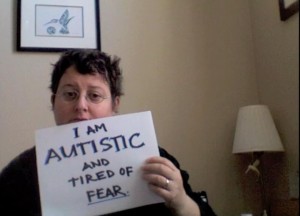 Despite a number of clarifications in The New York Times and on ABC News, NBC News, and CNN that Asperger’s is not a predisposing factor for premeditated violence, the spurious association of Asperger’s with the violence in Newtown, CT is still strong. In part, the media is responsible for not having clarified early on that yes, Adam Lanza shot 27 people and yes, Adam Lanza was apparently autistic, and no, one had nothing to do with the other. Such failures were rife. For example, in exploring a possible explanation for the shooting, Dr. Xavier Amador opined on Piers Morgan Tonight that people with Asperger’s are missing an essential element of humanity:
Despite a number of clarifications in The New York Times and on ABC News, NBC News, and CNN that Asperger’s is not a predisposing factor for premeditated violence, the spurious association of Asperger’s with the violence in Newtown, CT is still strong. In part, the media is responsible for not having clarified early on that yes, Adam Lanza shot 27 people and yes, Adam Lanza was apparently autistic, and no, one had nothing to do with the other. Such failures were rife. For example, in exploring a possible explanation for the shooting, Dr. Xavier Amador opined on Piers Morgan Tonight that people with Asperger’s are missing an essential element of humanity:
Well, actually, a symptom of Asperger’s, and this is one report coming out which may or may not be true, is something’s missing in the brain, the capacity for empathy, for social connection, which leaves the person suffering from this condition prone to serious depression and anxiety.
But the media’s response is only a symptom of a much larger problem. Its willingness to blame Asperger’s is a reflection of a cultural association between disability and evil that has lasted for centuries. As Colin Barnes writes:
Throughout the Middle Ages, disabled people were the subject of superstition, persecution, and rejection. Haffter (1968) has pointed out that in medieval Europe disability was associated with evil and witchcraft. Deformed and disabled children were seen as ‘changelings’ or the Devil’s substitutes for human children, the outcome of their parents’ involvement with the black arts of sorcery. The Malleus Maleficarum of 1487 declared that these children were the product of the mothers’ intercourse with Satan… Protestant reformer Martin Luther (1483-1546) proclaimed that he saw the Devil in a profoundly disabled child. If these children lived, Luther recommended killing them.” (Barnes 2010, 21)
Nineteenth- and twentieth-century eugenicists picked up this connection between disability and depravity, believing “that there were genetic links between physical and mental impairments, crime, unemployment and other social evils” (Barnes 2010, 26). The linkage has come down to the present day in the pernicious belief that disability is synonymous with narcissism and anti-social behavior (Siebers 2011, 34-35).
I’ve read a number of comments online that suggest that autistic people and autism parents are overplaying the scapegoating of Asperger’s. People say that the mainstream media has issued its clarifications and that the problem is solved. Unfortunately, it’s not that easy. Once this iteration of the cultural narrative about disability hit the airwaves, it quickly took root among ordinary people. Giving life to a well-worn untruth while people are in a state of nearly irrational fear is a difficult thing to undo. To give you a sense of just how deep the damage goes, I offer the following examples.
On the Volconvo forum, one commenter refers to people with autism and mental illness as “broken-minded defects” who are “dangerous” and whom society needs to monitor and imprison inside locked wards:
A commenter on a TIME article suggests that autistic people are “mutants” who need to be placed in “psychiatric facilities” and ultimately removed from the gene pool for the good of society:
And then there was the person who started a Facebook page and called for the killing of autistic children. (To its credit, Facebook quickly removed the page.)
This kind of scapegoating has begun the inevitable creep off the major news sites and social media and into the lives of ordinary autistic people and their families. Three friends have given me permission to share their experiences.
Here is the story told by my friend Sara, a woman with Asperger’s. While standing at the post office five days after the tragedy, she spoke to a woman, an Ivy League graduate, who said that Asperger’s — and Asperger’s alone — had caused the Sandy Hook shooting. Sara posted the following on her Facebook status:
Another friend describes a situation in which a false belief in a link between autism and violence caused his wholly nonviolent autistic child to become suspect in the eyes of a relative:
Finally, my friend C describes a more frightening scenario. Her son J, who is 14 years old, had gone to Wal-Mart to look for a Christmas tree. He has Asperger’s and bipolar disorder, and people in his community are aware of his diagnoses. He was wearing headphones to block out sensory input, and, at one point, attempted to find a quieter place in the store. He had his hand on a price list in his pocket when someone who knew him went into a panic — a panic that resulted in the young man’s injury:
Like Trayvon Martin in his hoodie, the scary guy on the block appears to be, in the minds of some people, the kid with Asperger’s with his hands in his pockets. I’m just waiting for someone to suggest that, as Geraldo Rivera said about black men giving up their hoodies, young men with Asperger’s should wear pocketless clothing.
The stunning level of irrationality and fear being leveled at people with autism is tremendous cause for concern. In the face of this scapegoating, autistic people and autism parents are countering with positive images of autistic children and adults that show us as full human beings — ordinary, extraordinary, beautiful, and proud. To see these images, please go to the following Facebook pages:
Autism Shines
Autistics, Not Monsters
Disability and Representation
Let’s spread the word to end the scapegoating. And let’s keep doing it, now and always, wherever and whenever we can.
References
Barnes, Colin. “A Brief History of Discrimination and Disabled People.” In The Disability Studies Reader, edited by Lennard J. Davis, 20-32. New York: Routledge, 2010.
Christopher, Tommy. “Piers Morgan Quack Says People With Autism Lack Empathy: ‘Something’s Missing In The Brain’.” Mediaite, December 14, 2012. Accessed December 24, 2012. http://www.mediaite.com/tv/piers-morgan-quack-says-people-with-autism-lack-empathy-somethings-missing-in-the-brain/.
Facebook. www.facebook.com. Accessed December 24, 2012.
— “Autism Shines.” http://www.facebook.com/AutismShines?fref=ts. Accessed December 24, 2012.
— “Autistics, Not Monsters.” http://www.facebook.com/AutisticsNotMonsters?ref=ts&fref=ts. Accessed December 24, 2012.
— “Disability and Representation.” http://www.facebook.com/DisabilityAndRepresentation. Accessed December 24, 2012.
Falco, Miriam. “Groups: Autism not to blame for violence. CNN, December 19, 2012. Accessed December 24, 2012. http://www.cnn.com/2012/12/17/health/connecticut-shooting-autism/index.html.
Fox, Maggie. “Asperger’s not an explanation for Lanza’s Connecticut killing spree, experts say.” NBC News, December 18, 2012. Accessed December 24, 2012. http://vitals.nbcnews.com/_news/2012/12/18/15994353-aspergers-not-an-explanation-for-lanzas-connecticut-killing-spree-experts-say?lite.
Gilman, Priscilla. “Don’t Blame Autism for Newtown.” The New York Times, December 17, 2012. Accessed December 24, 2012. http://www.nytimes.com/2012/12/18/opinion/dont-blame-autism-for-newtown.html.
Nano, Stephanie. “Experts: No Link Between Asperger’s, Violence. ABC News, December 16, 2012. Accessed December 24, 2012. http://abcnews.go.com/US/wireStory/experts-link-aspergers-violence-17987339#.UNj7VHfLBQG.
Rochman, Bonnie. “Guilt by Association: Troubling Legacy of Sandy Hook May Be Backlash Against Children with Autism.” TIME, December 19, 2012. Accessed December 24, 2012. http://healthland.time.com/2012/12/19/guilt-by-associationtroubling-legacy-of-sandy-hook-may-be-backlash-against-children-with-autism/.
Siebers, Tobin. Disability Theory. Ann Arbor, MI: University of Michigan Press, 2011.
Volconvo. “Kindergarten isn’t just about identifying colors, shapes and sizes anymore.” http://www.volconvo.com/forums/society-rights/43038-kindergarten-isn-t-just-about-identifying.html. December 14, 2012. Accessed December 24, 2012.
© 2012 by Rachel Cohen-Rottenberg
It’s Happened Again: Apparently, It’s Let’s Publicly Defame a Family Member By Comparing Him to Adam Lanza Week
Last Friday, there was the infamous I Am Adam Lanza’s Mother piece.
This Friday, there is an equally disgraceful piece called My brother is not Adam Lanza, but he could be, in which the author, under her own name, with a photo of her brother, says that he could be the next Adam Lanza. Or that he could have been. If his parents hadn’t done such a good job. And he weren’t such a nice person. Or something.
Please, dear readers, answer me two questions: What makes people unable to restrain themselves from blowing the privacy of family members? And what compels them to put a photo of a family member in a piece in which said family member is likened to Adam Lanza?
The author acknowledges that Asperger’s isn’t associated with violence. She acknowledges that her brother, who has Asperger’s, has never committed a violent act in his life. The closest he has ever come has been to get up into her face, with his fists, once.
It was only years later as I watched my brother shaking with rage, as he struggled to hold himself together, with his fist clenched inches from my face that I understood how intense frustration and pain could explode out of a person.
…
He has never hit me, or any family member, although there are times he uses up every ounce of self- control restraining himself. This incredible effort and bravery, is testament to his goodness.
On these rare occasions I wonder what it would take to push him over the edge. Is that the difference between him and Adam Lanza?
So, apparently, in the mind of Pamela Mirghani, shaking with rage at a family member, if the person shaking with rage happens to have Asperger’s, suggests a risk for committing mass murder. I can’t even begin to parse the logic there, because there isn’t any. The statement is completely prejudicial. Does she realize how many non-autistic people get up in other people’s faces with their fists, and worse, and don’t go on to shoot up schools?
Millions of people, all over the world, feel like hitting people and they don’t do it. And millions of people, all over the world, feel like hitting people and — unlike her brother — they do. Does that make all of these people potential mass murderers? Of course not. And even if it did, why in God’s name link it to Asperger’s, especially when she admits that Asperger’s isn’t linked to violence at all:
While violence may not be linked to autism, frustration is. Without the tools, help and support to cope with that frustration it can overwhelm the sufferer.
I am not Adam Lanza’s sister. My brother is NOT Adam Lanza. But he could have been, maybe could still be under certain circumstances. And acknowledging this is not wrong.
Yes, folks. She just said that her brother with Asperger’s, who has never been violent, who on “rare occasions” has gotten so upset that he wanted to hit someone, could become a mass murderer under certain circumstances — purely because his Asperger’s makes him frustrated. Of course, that blithely ignores the fact that all studies show that Asperger’s is not associated with premeditated violence, and that there is no evidence that mere frustration makes someone load weapons into his car, drive to a school, and commit murder and mayhem. But hey, who needs studies — not to mention common sense — when you can defame and violate the privacy of a family member for no good reason?
So yes, Pamela. Acknowledging something, when it’s entirely false, prejudicial, and defamatory, is wrong. Saying that anyone with Asperger’s could become a mass murderer under certain circumstances, simply because the person has Asperger’s, is wrong. Saying that your own brother could become a mass murderer, merely because he shares a diagnosis with someone who just committed an unthinkable act, is wrong. There is nothing about Asperger’s that predisposes people to premeditated violence. Nothing at all.
To suggest that your brother with Asperger’s is capable of such a thing, purely because of his disability, not only tars and feathers him, but also tars and feathers everyone who has Asperger’s.
Do you know what that means? Do you know the harm that could come from articles like this one? Do you know the kind of fear that autistic people are feeling right now because we’re being scapegoated in the media for the evil that was done last week? Any idea at all? Do you know how this stigmatizes your brother? Do you understand the humiliation involved in calling him a potential mass murderer? Do you grasp the fact that it puts your brother — and all of us — in potential danger for you to say such a thing in public?
Great job, Pamela. What a nice Christmas present to your brother, to autistic people, and to those who love us. Merry Christmas to you, too.
References
The Huffington Post. “‘I Am Adam Lanza’s Mother’: A Mom’s Perspective On The Mental Illness Conversation In America.” http://www.huffingtonpost.com/2012/12/16/i-am-adam-lanzas-mother-mental-illness-conversation_n_2311009.html. December 16, 2012. Accessed December 16, 2012.
Mirghani, Pamela. “My brother is not Adam Lanza, but he could be.” National Times. December 21, 2012. Accessed December 21, 2012. http://www.watoday.com.au/opinion/my-brother-is-not-adam-lanza-but-he-could-be-20121221-2bql1.html.
Note: Anyone who would like to protest the nature of Pamela Mirghani’s article is welcome to share a link to this piece in an email to news@watoday.com.au. You can also find WA Today, on whose site the piece appears, on Twitter at @watoday.
© 2012 by Rachel Cohen-Rottenberg
